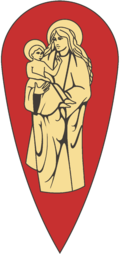Banff, Scotland
Banff
|
|
|---|---|
 Banff |
|
 Coat of arms of Banff |
|
| Banff shown within Aberdeenshire | |
| Population |
3,991 (2001 census) |
| OS grid reference | NJ688642 |
| Council area | |
| Lieutenancy area | |
| Country | Scotland |
| Sovereign state | United Kingdom |
| Post town | BANFF |
| Postcode district | AB45 |
| Dialling code | 01261 |
| Police | Scottish |
| Fire | Scottish |
| Ambulance | Scottish |
| EU Parliament | Scotland |
| UK Parliament | |
| Scottish Parliament | |
3,991 (2001 census)
Banff /ˈbænf/ is a town in the Banff and Buchan area of Aberdeenshire, Scotland. Banff is situated on Banff Bay and faces the town of Macduff across the estuary of the River Deveron. Banff is a former royal burgh, and is the traditional county town of Banffshire.
The origin of the name is uncertain. It may be derived from the Scottish Gaelic banbh meaning 'piglet'; buinne, a stream; or a contraction of Bean-naomh meaning 'holy woman' (as reflected in the burgh's coat of arms which features the Virgin Mary).William J. Watson writes: "It is true that Banff is Banb in the Book of Deer and Banbh in modern Gaelic — one syllable. On the other hand, banbh, a sucking pig, is not appropriate — one might say it is impossible — as the name of a place or district."
Banff's first castle was built to repel Viking invaders and a charter of 1163 AD shows that Malcolm IV was living there at that time. During this period the town was a busy trading centre in the "free hanse" of Northern Scottish burghs, despite not having its own harbour until 1775. The first recorded Sheriff of Banff was Richard de Strathewan in 1264, and in 1372 Royal Burgh status was conferred by King Robert II. By the 15th century Banff was one of three principal towns exporting salmon to the continent of Europe, along with Aberdeen and Montrose.
...
Wikipedia

